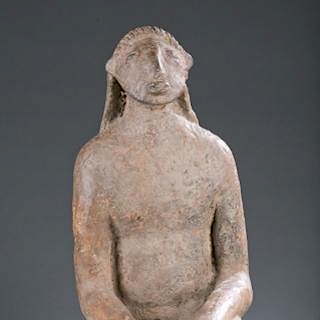Fan monkey figure, 20th century.
Lot 364
About Seller
Quinn's Auction Galleries
360 S. Washington Street
Falls Church, VA 22046
United States
Quinn's Auction Galleries is a full service auction and estate services company. We have a range of specialties, from fine art & antiques, to rare books & maps.
Categories
Estimate:
$3,000 - $5,000
Absentee vs Live bid
Two ways to bid:
- Leave a max absentee bid and the platform will bid on your behalf up to your maximum bid during the live auction.
- Bid live during the auction and your bids will be submitted real-time to the auctioneer.
Bid Increments
| Price | Bid Increment |
|---|---|
| $0 | $10 |
| $300 | $25 |
| $500 | $50 |
| $1,000 | $100 |
| $3,000 | $250 |
| $5,000 | $500 |
| $15,000 | $1,000 |
| $20,000 | $2,000 |
| $30,000 | $2,500 |
| $100,000 | $5,000 |
About Auction
By Quinn's Auction Galleries
Oct 1, 2016 - Oct 2, 2016
Set Reminder
2016-10-01 11:00:00
2016-10-02 11:00:00
America/New_York
Bidsquare
Bidsquare : Estate of Merton Simpson & Multi Estate Ethnographic
https://www.bidsquare.com/auctions/quinns/estate-of-merton-simpson-multi-estate-ethnographic-1779
Quinn's Auction Galleries dquinn@quinnsauction.com
Quinn's Auction Galleries dquinn@quinnsauction.com
- Lot Description
A crouching male Bulu monkey figure with armsbent at the elbow. Cameroon, Fang. 20th century. 21"h x 8 1/2"w x 9"d.
Provenance: Inventory and Collection from the Estate of Merton D. Simpson. "Simpson inventory# 8254 acquired August 29, 1996 asking $100,000. Catalog Notes: “From 1880-1910 the Bulu, like the Fang practiced an ngi ritual against sorcery, in particular against poisonings. The “ngi” is the gorilla a fearful animal, with which the candidate identifies after he has been accepted into the association. Fewer than ten monkey statues are existing that we know of. The inventiveness of their round, simple forms is striking and the artists have captured with great precision the animal’s posture."" L. Perrois, La Sculpture Traditionanelle du Gabon. (1973) A.R.Walker and R. Sillans, Rites et Croyances des Peuples du Gabon’s (1962) Paul Du Chaillu already wrote in 1891 about gorilla stories he had heard from the Fang and Bulu people. For example, the Fang were convinced that if a pregnant woman or her husband were to see a gorilla, even a dead one, she would give birth to a gorilla, rather than to a human child. It is very difficult to find published information on this subject, as little has been written since about the importance of gorillas for African peoples. One exception is Gunter Tessmapn’s study of the Pangwe (Cameroon and Gabon) published in 1913. It contains a detailed description of a secret society whose cult centres around the gorilla. It was widely spread and called Ngi or Ngui among the Fang and Nji among the Bulu. Ngi means gorilla and is the symbol of fire and positive power (the chimpanzee represents evil). During the Ngi celebration, a large sculpture was made after the vigorous dance of a healer. Certain objects were placed in and around that sculpture, for example, parts of dead people (but not gorillas), and rituals were performed. For the members of the Ngi secret society, Ngi was watching their manners. He punished them with illness, for example with leprosy, if they broke the rules. Ngi also protected the society members as he rose at night to fight sorcerers who had left their bodies to kill people. According to Jordi Sabater Pi, the Ngi cult has disappeared completely. However, Klaus Paysan heard from a chief’s son in Cameroon, far away from the present gorilla distribution area, that the Ngi society was still active, but all information was kept absolutely secret.” Exquisiteafricanart.com" - Shipping Info
-
Shipping and Handling Policy:
Quinn's Auctions ONLY ships with FedEx Domestic and USPS internationally. We do not ship Media Mail. Shipping costs are based on the weight of your lots and your location. We require a complete shipping address and phone number to process your shipping quote. You will receive your shipping quote in your invoice via your registered email with a tracking number if available. Once payment is received Quinns will ship items FedEx ground in the United States, USPS International or release items to an outside shipper.Quinn's Auctions reserves the right to recommend an outside shipper based on fragility and size of lot. We offer recommendations for outside shipping by trusted shippers if necessary. If using an outside shipper Quinn's Auctions is not responsible for damages by carriers or packers of purchased lots, whether or not recommended by Quinn's Auctions and will not be liable for any losses which result.
-
- Buyer's Premium



 EUR
EUR CAD
CAD AUD
AUD GBP
GBP MXN
MXN HKD
HKD CNY
CNY MYR
MYR SEK
SEK SGD
SGD CHF
CHF THB
THB















